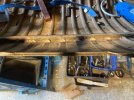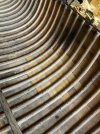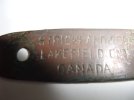Hello, another new member, who's finally got enough time to get to grips with the bright ideas of his youth. My Strickland has been sitting in the garage for 35 years and seems fairly complete, the main problems


being a 6" hole, carefully fibreglassed, numerous cracked ribs and 2 large, rough bilge strakes. The canoe is 28 1/2" or 31" from the outwales and 14' 7" long.
So, I've spent some time scaping the inside. I then started on the hole and realised that, to remove the ribs I'd have to remove the inwale. Unfortunately that had been attached with mild steel screws and the heads had rusted. I finally found a small disc cutting wheel large enough (50mm) to cut the screw heads off from underneath, in the hope that I could then remove the inwale and expose the tops of the ribs. No luck, the screw shanks were rusted and were still holding the wood.
Then I made a hollow drill to clear the wood around the shanks, fairly hard steel required. One inwale came off fairly easily, the other needed more drilling. Most of the screws then had to be cut as they were too weak or too rusted in. I could now remove ribs and work out how much shiplap cedar was needed.
In the 3rd photo, I have marked with red tape where I think I should cut. I've come across one scarf joint, 45 degrees and positioned under a rib, so the three nails fastening the joint also go through the rib. Do you seasoned repairers feel I've allowed enough new material, spread out enough?
Also, there is a kelson and I'm fairly sure the ribs originally continued underneath. I was planning to replace just half the total length of rib, so I need to remove some of the old rib under the kelson (there is a further nail through rib and kelson). Is there an accepted method?

Many thanks for any suggestions,
Charlie.
being a 6" hole, carefully fibreglassed, numerous cracked ribs and 2 large, rough bilge strakes. The canoe is 28 1/2" or 31" from the outwales and 14' 7" long.
So, I've spent some time scaping the inside. I then started on the hole and realised that, to remove the ribs I'd have to remove the inwale. Unfortunately that had been attached with mild steel screws and the heads had rusted. I finally found a small disc cutting wheel large enough (50mm) to cut the screw heads off from underneath, in the hope that I could then remove the inwale and expose the tops of the ribs. No luck, the screw shanks were rusted and were still holding the wood.
Then I made a hollow drill to clear the wood around the shanks, fairly hard steel required. One inwale came off fairly easily, the other needed more drilling. Most of the screws then had to be cut as they were too weak or too rusted in. I could now remove ribs and work out how much shiplap cedar was needed.
In the 3rd photo, I have marked with red tape where I think I should cut. I've come across one scarf joint, 45 degrees and positioned under a rib, so the three nails fastening the joint also go through the rib. Do you seasoned repairers feel I've allowed enough new material, spread out enough?
Also, there is a kelson and I'm fairly sure the ribs originally continued underneath. I was planning to replace just half the total length of rib, so I need to remove some of the old rib under the kelson (there is a further nail through rib and kelson). Is there an accepted method?
Many thanks for any suggestions,
Charlie.



